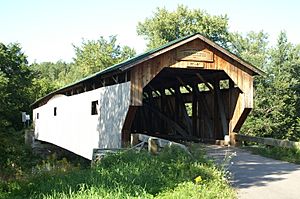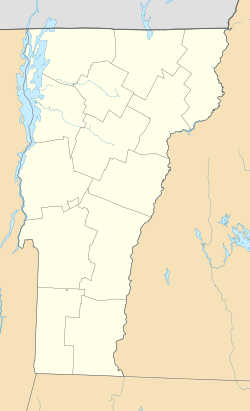Poland Covered Bridge facts for kids
Quick facts for kids Poland Covered Bridge |
|
|---|---|

Bridge in U.S. state of Vermont
|
|
| Carries | Automobile |
| Crosses | Lamoille River |
| Locale | Cambridge, Vermont |
| Maintained by | Town of Cambridge |
| ID number | VT-08-02 |
| Characteristics | |
| Design | Covered, Burr arch |
| Material | Wood |
| Total length | 152.9 ft (46.60 m) |
| Width | 15.7 ft (4.79 m) |
| Number of spans | 1 |
| Load limit | 3 tons |
| Clearance above | 11.5 ft (3.51 m) |
| History | |
| Constructed by | George W. Holmes |
| Construction end | 1887 |
| Area | 1 acre (0.4 ha) |
| NRHP reference No. | 74000230 |
| Added to NRHP | October 9, 1974 |
The Poland Covered Bridge is a special kind of bridge called a covered bridge. It's also known as the Junction Covered Bridge or the Cambridge Junction Covered Bridge. This historic bridge helps cars cross the Lamoille River in Cambridge, Vermont. It was built way back in 1887 by George W. Holmes. The bridge has a unique Burr arch design. In 1974, it was added to the National Register of Historic Places, which means it's an important landmark!
Why the Poland Bridge Name?
The bridge got its name from a local leader, Judge Poland. When it was built in 1888, some people in Cambridge weren't happy. They thought the bridge and its new road cost too much money.
One newspaper article from 1888 said the bridge would only benefit Judge Poland. It even joked that taxpayers would call it "The Bridge of Sighs." Sadly, Judge Poland passed away soon after the bridge was finished. He never got to use it.
Poland Bridge Design and Location
The Poland Covered Bridge is found just east of Jeffersonville. It stretches across the Lamoille River, connecting two roads. These roads are Vermont Route 15 on the south side and Vermont Route 109 on the north side.
The bridge is about 152.5 feet (46.5 meters) long. It is 19.5 feet (5.9 meters) wide, with one lane for cars. The bridge is built with strong wooden supports called Burr trusses. These trusses have curved arches inside them. The bridge also has a special beam bolted underneath for extra strength.
The bridge sits on stone foundations, which have concrete caps. The outside of the bridge is covered with vertical wooden boards. These boards also go inside the bridge's entrances. On the sides, the boards follow the curve of the arches, stopping before the roof.
Recent Repairs and Upgrades
Over many years, the Poland Covered Bridge started to lean. Then, in 1995, a vehicle hit one of its main support posts. This hit actually straightened the lean, but it also damaged the bridge's support system.
Because of the damage, the bridge needed major repairs. Reconstruction began in 2003 by Alpine Construction. The bridge was proudly reopened on July 4, 2004. This big project received $1 million in support from the National Historic Bridge Program. This funding helped make sure the historic bridge could be saved.
Now, the bridge has short "tire rails" on each side of the road. These rails help stop vehicles from hitting the bridge's sides again. It seems they are working well, as they show signs of having been hit!



